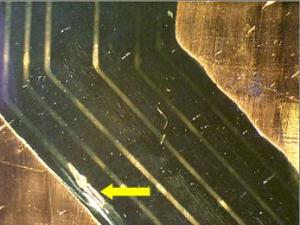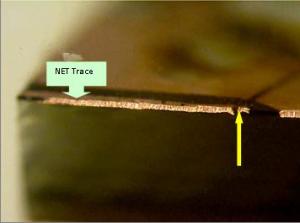Tin Whisker Growth in Solder Mask
Gideon Analytical Laboratories received a PCB for failure analysis. The board was identified as having a short from the NET trace to the ground. The short measured about 10 ohms. One area of the board was abraded to reduce the thickness of the black solder mask. The board was received like this and we tried to change the refractive index to optically see through the solder mask. This was unsuccessful. The abraded area produces different optical characteristics, which prevent clear optical vision. Radiography did not work at all because the beam intensity attenuates and washes out any slivers traces that maybe there and works in principle by a density difference from the surrounding materials. Acoustic (sound waves, CSAM) microscopy did not work because either there are too many interfaces or the sliver may be too fine or the location is known in the material’s matrix.
Next, the solder mask was removed from the copper. In this process, we do not use water and the short never disappeared. This solder mask has been thinned down and copper fibers can be seen in the mask. These were not visible before the thinning. The reason for the shorting lies in the trough between the ground plane and the Net trace line, a short distance from the mark that was on the PCB (noted by the arrow in the picture at the top left).
To picture at the top right is the cross-section. The short lies between the cut (the arrow in yellow) and the trough to the left. The long area on the trace line allowed polishing the trace line to a point before it fades away, thus maximizing the chance of finding it. The next step was polish, test, polish, test, etc., until the short disappears. At that point, the short will have been located.
Net results of failure analysis revealed that these problems have originated in the processing of the board during and prior to the solder mask application. The copper fibers in the solder mask are related to cleaning. The screen may be contaminated, the PCB may have had fibers on it, or the resist may need changing more frequently. Although we did not find these fibers to cause the short, they are certainly long enough to transgress two contiguous trace lines and, therefore, pose a substantial threat to leakage current. This mask had residual tin within the solder mask and exposure to humid conditions promoted the growth for over six weeks. The SEM-EDS was used in the end for identification.
Companies that have taken the time to find the problem and identify the problem can then find the solution the best address all the concerns. A change in solder mask procedures and shelf life prevented future failures. Does your company have a problem with a process, components, design, manufacturing, assembly, or field failures? Gideon Analytical Laboratories can address these types of issues.

Black Solder Mask with embedded tin

Copper Trace line shorting to adjacent trace